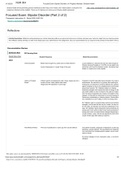Exam (elaborations)
NURS 611 ADVANCED PATHOPHYSIOLOGY EXAM KEYPOINTS STUDIED AND REVISED FOR A GUARANTEE PASS
- Institution
- Maryville University Of St. Louis
NURS 611 ADVANCED PATHOPHYSIOLOGY EXAM KEYPOINTS STUDIED AND REVISED FOR A GUARANTEE PASS Exam 1: Know Cell components and what they do: · Nucleus- Located in the center of the cell and contains the nucleolus which is composed of DNA, RNA, histones, and chromosomes. Primary functions ar...
[Show more]












